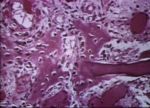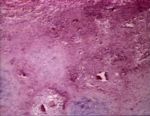Difference between revisions of "Fractures"
Jump to navigation
Jump to search
| Line 1: | Line 1: | ||
| − | * [[ | + | ===Causes of Fracture=== |
| − | * [[ | + | * The causes of fracture fit into two distinct categories: |
| − | * [[ | + | *# '''Fracture of trauma''' |
| − | * [[ | + | *#* Breakage of normal healthy bone due to excessive stress pressure of short duration. |
| + | *# '''Pathological fracture''' | ||
| + | *#* Breakage of bone weakened by some underlying metabolic, inflammatory or neoplastic condition. | ||
| + | |||
| + | ===Description of a Fracture=== | ||
| + | * There are various terms to describe a fracture's appearance. | ||
| + | * Separation of the ends of the fracture may be '''complete''' or '''incomplete'''. | ||
| + | * When there is no penetration of the overlying skin, a the fracture is described as '''closed'''. | ||
| + | * When the sharp ends penetrate the overlying skin, the fracture is '''compound'''. | ||
| + | ** In this scenario there is the danger of introducing infection. | ||
| + | *'''Comminuted''' describes a fracture where there are multiple small fragments of bone at the site of breakage. | ||
| + | * Where the edges of the fracture are impacted into each other, the fracture is said to be '''compressed'''. | ||
| + | * When one side of the fracture is depressed below the plane of the other, the term '''depressed''' is used. | ||
| + | ** This occurs in the flat bones of the skull. | ||
| + | * '''Microfractures''' are fractures that are only visible on histological section as cracks in the bone. | ||
| + | ** Grossly, there might be evidence of some haemorrhage in the area. | ||
| + | |||
| + | ===Fracture Repair=== | ||
| + | [[Image:fracture repair.jpg|thumb|right|150px|Fracture repair (Courtesy of BioMed Archive)]] | ||
| + | * On breakage, there is rupture of the periosteal, cortical and medullary vessels, causing: | ||
| + | ** A blood clot in the breakage area. | ||
| + | *** Fibrin is the important component. | ||
| + | ** Local necrosis of tissue supplied by these vessels. | ||
| + | *** This lowers the local pH. | ||
| + | * The fate of the blood clot depends upon its location. | ||
| + | ** The periosteal portion is lysed and disappears; | ||
| + | ** The medullary portion is removed by macrophages. | ||
| + | * The necrotic material is removed by phagocytosis. | ||
| + | ** Necrotic [[Bone Marrow - Anatomy & Physiology|bone marrow]] is removed by [[Macrophages|macrophages]]. | ||
| + | *** This is a fairly rapid process. | ||
| + | ** Osteoclasts remove necrotic bone. | ||
| + | *** This is a slow process. | ||
| + | * On the periosteal side, the periosteum proliferates into the clot. | ||
| + | ** Forms a fibrous collar around the bone called the soft callus. | ||
| + | * The cells in the inner aspect of the soft callus, particularly those near the fracture fragments, differentiate into osteoblasts. [[Image:fracture callus.jpg|thumb|right|150px|Fracture callus (Courtesy of BioMed Archive)]] | ||
| + | ** Grow across the divide between the two fragments, laying down coarse woven bone. | ||
| + | * The woven bone laid is known as the hard callus. | ||
| + | ** This periosteal coarse bone is of utmost importance in repair. | ||
| + | *** It is responsible for much of the strength of the fracture repair. | ||
| + | ** This is replaced over a period of time by mature compact bone. | ||
| + | *** Aligns itself according to the stresses applied to it. | ||
| + | * Periosteal cells that are further away from the fracture fragments differentiate into cartilage-producing cells. | ||
| + | ** Produce a cone of cartilage between the two fragments. | ||
| + | *** As the local pH changes to more alkaline conditions, this cartilage undergoes calcification, with invasion by blood vessels and osteoblasts. | ||
| + | **** The cartilage is replaced by bone - endochondral ossification. | ||
| + | * On the medullary side, the endosteum proliferates and invades the clot, laying down bone. | ||
| + | ** This bone may totally occlude the medulla and is later remodelled to reconstitute a patent lumen. | ||
| + | |||
| + | ===Complications=== | ||
| + | * There are several possible complications that may arise in the repair of bone. | ||
| + | # Inadequate immobilisation of the fractured ends will lead to incomplete repair by callus formation. | ||
| + | #* An intervening mass of fibrocartilage remains, forming a false joint. | ||
| + | #** In some cases the false joint can even appear to form a synovial lining. | ||
| + | #* If the fractured ends are sufficiently far apart, no substantial callus forms. | ||
| + | #** The intervening space is taken up by connective tissue organisation. | ||
| + | # Failure to align the fractured ends in proper apposition to one another will produce excessive callus. | ||
| + | #* This takes a longer time to be remodelled by the adult compact bone. | ||
| + | # [[Healing and Repair - Pathology#Description of a Fracture|Comminution]] delays healing due to persistent irritation. | ||
| + | # Infection delays healing due to the effects of the toxins on theproliferating cells. | ||
| + | #* May give rise to a systemic infection affecting the rest of the body. | ||
Revision as of 18:33, 27 February 2011
Causes of Fracture
- The causes of fracture fit into two distinct categories:
- Fracture of trauma
- Breakage of normal healthy bone due to excessive stress pressure of short duration.
- Pathological fracture
- Breakage of bone weakened by some underlying metabolic, inflammatory or neoplastic condition.
- Fracture of trauma
Description of a Fracture
- There are various terms to describe a fracture's appearance.
- Separation of the ends of the fracture may be complete or incomplete.
- When there is no penetration of the overlying skin, a the fracture is described as closed.
- When the sharp ends penetrate the overlying skin, the fracture is compound.
- In this scenario there is the danger of introducing infection.
- Comminuted describes a fracture where there are multiple small fragments of bone at the site of breakage.
- Where the edges of the fracture are impacted into each other, the fracture is said to be compressed.
- When one side of the fracture is depressed below the plane of the other, the term depressed is used.
- This occurs in the flat bones of the skull.
- Microfractures are fractures that are only visible on histological section as cracks in the bone.
- Grossly, there might be evidence of some haemorrhage in the area.
Fracture Repair
- On breakage, there is rupture of the periosteal, cortical and medullary vessels, causing:
- A blood clot in the breakage area.
- Fibrin is the important component.
- Local necrosis of tissue supplied by these vessels.
- This lowers the local pH.
- A blood clot in the breakage area.
- The fate of the blood clot depends upon its location.
- The periosteal portion is lysed and disappears;
- The medullary portion is removed by macrophages.
- The necrotic material is removed by phagocytosis.
- Necrotic bone marrow is removed by macrophages.
- This is a fairly rapid process.
- Osteoclasts remove necrotic bone.
- This is a slow process.
- Necrotic bone marrow is removed by macrophages.
- On the periosteal side, the periosteum proliferates into the clot.
- Forms a fibrous collar around the bone called the soft callus.
- The cells in the inner aspect of the soft callus, particularly those near the fracture fragments, differentiate into osteoblasts.
- Grow across the divide between the two fragments, laying down coarse woven bone.
- The woven bone laid is known as the hard callus.
- This periosteal coarse bone is of utmost importance in repair.
- It is responsible for much of the strength of the fracture repair.
- This is replaced over a period of time by mature compact bone.
- Aligns itself according to the stresses applied to it.
- This periosteal coarse bone is of utmost importance in repair.
- Periosteal cells that are further away from the fracture fragments differentiate into cartilage-producing cells.
- Produce a cone of cartilage between the two fragments.
- As the local pH changes to more alkaline conditions, this cartilage undergoes calcification, with invasion by blood vessels and osteoblasts.
- The cartilage is replaced by bone - endochondral ossification.
- As the local pH changes to more alkaline conditions, this cartilage undergoes calcification, with invasion by blood vessels and osteoblasts.
- Produce a cone of cartilage between the two fragments.
- On the medullary side, the endosteum proliferates and invades the clot, laying down bone.
- This bone may totally occlude the medulla and is later remodelled to reconstitute a patent lumen.
Complications
- There are several possible complications that may arise in the repair of bone.
- Inadequate immobilisation of the fractured ends will lead to incomplete repair by callus formation.
- An intervening mass of fibrocartilage remains, forming a false joint.
- In some cases the false joint can even appear to form a synovial lining.
- If the fractured ends are sufficiently far apart, no substantial callus forms.
- The intervening space is taken up by connective tissue organisation.
- An intervening mass of fibrocartilage remains, forming a false joint.
- Failure to align the fractured ends in proper apposition to one another will produce excessive callus.
- This takes a longer time to be remodelled by the adult compact bone.
- Comminution delays healing due to persistent irritation.
- Infection delays healing due to the effects of the toxins on theproliferating cells.
- May give rise to a systemic infection affecting the rest of the body.

